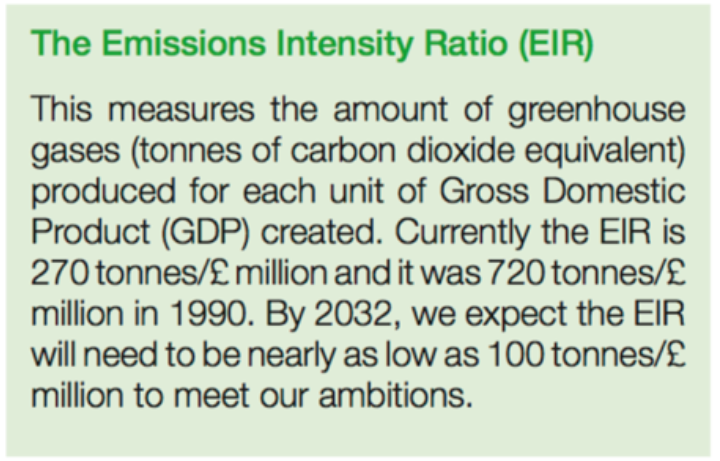Emissions Intensity Ratio: the new panacea?
The launch of a new decarbonisation metric is imminent, but what does it tell us?
By Jonny Marshall
Share
Last updated:
While the government has come under criticism for its actions on low carbon support in recent weeks, the rhetoric that accompanies the UK’s ongoing decarbonisation certainly remains steadfast. Green groups have long waited for a minister as vocally enthusiastic about the UK’s transition to a low carbon economy as Claire Perry, the minister of state for energy and clean growth, who clearly relishes the opportunity to big up the UK’s progress.
Whether it is the UK’s G7-leading pace of decarbonising, the fact that more than half of electricity was generated from low carbon sources in 2017, or that the cost of signed offshore wind contracts has halved inside four years, it cannot be denied that the current minister enjoys deploying a good statistic.
And looking inside the government’s clean growth strategy, it appears that the UK is set to be blessed with another marker against which progress can be measured. With the argument that cutting carbon does not mean abandoning economic progress now rightly put to bed, the government is set to use ‘emissions intensity’ – comparing national emissions with GDP – as a yardstick.
New Numbers
The emissions intensity ratio (EIR) incorporates economic performance into an official decarbonisation measurement for the first time, allowing onlookers to keep tabs on progress towards goals set out in the Climate Change Act, and ensuring that UK PLC grows throughout.

To meet the fifth carbon budget, the government expects the 2032 economy to produce 100 tonnes of carbon dioxide for every £million of GDP, a far cry from the 1990 figure of 700 tonnes per £million. However, the UK’s rapid decarbonisation of the power sector since the early 1990s – first through the ‘dash for gas’, and more recently through the phasing out of coal for electricity generation – means this target is not as far-fetched as it may first seem, even as the emissions of other sectors have remained steady.
Analysis of governmental data shows that in 2017, the UK’s EIR had fallen to less than 235 tCO2e/£million – a fall of nearly two thirds inside 30 years. This must surely be the final nail in the coffin for the Lawsonian economy vs environment fallacy, and is likely to spur on ministers to continue talking the talk (especially if, as expected, this new statistic is rolled out during Green Great Britain Week in October).

Falling from 243 tCO2/£m to 232.5 tCO2/£m, the UK’s EIR decreased by 4.3% between 2016 and 2017. Despite representing good progress, this is less than the 5%/year fall targeted in the Clean Growth Strategy (see figure).
This target was missed despite annual emissions from the power sector falling by 8% year on year, while emissions from residential and public sectors were also lower, by 4% and 3% respectively.
During 2017, the rate of GDP growth increased throughout the year, driven largely by business and financial services. Strong performance from the manufacturing sector also boosted the British economy, offsetting slower growth in household spending.
Eurostat data shows that the UK economy grew by 1.8% during 2017, down 0.1% on 2016 growth, and 0.3% below economic growth across the EU-27.
Sticky progress on business and transport emissions knocked the metric off-progress, and may cause concern for future years.
Projections
Looking ahead, BEIS and ONS forecasts suggest that, by 2022, emissions will have fallen by 12.3% and GDP (real) will be 7% higher, both in reference to 2017. This suggests an overall reduction in EIR over the five-year period of 20.7%, suggesting that the Government will continue to miss its 5%/year target as we move into the next decade.
It is also notable that much of the lowest hanging fruit has now been picked, with coal use nearly completely cut out from the power sector during 2017, for example. Therefore, to maintain an annual 5% fall in EIR the government may be looking for means to boost GDP rapidly, or to tackle harder to decarbonise sectors such as heating and heavy industry head on.
Broad Brush
But how reliable is this sort of metric? Does it offer an insight into progress towards existing (or even tightening) climate change targets?
The analogous energy intensity ratio (the amount of energy consumed to generate a certain amount of GDP) has long been celebrated for politicians looking to show that we are doing more with less energy, but has also been criticised for being unreliable, masking or over-exaggerating progress towards a real low carbon economy, or for avoiding reporting absolute emission figures.
For example, it can overstate ‘growth’ should the economy grow faster than emissions fall, or can skew figures should a recession or other shock event see GDP fall sharply.
It is also exaggerated by growing population figures, and doesn’t account for consumption-based emissions, which represent a growing share of total emissions for western nations.
Therefore, while the EIR may continue to be a source of good news for the government in years to come, its potential to either over or undersell progress means that its use should be treated with caution.
Share